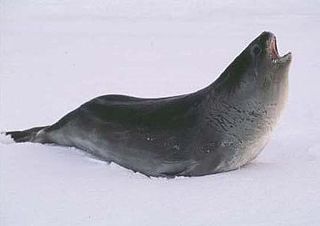
The earless seals, phocids, or true seals are one of the three main groups of mammals within the seal lineage, Pinnipedia. All true seals are members of the family Phocidae. They are sometimes called crawling seals to distinguish them from the fur seals and sea lions of the family Otariidae. Seals live in the oceans of both hemispheres and, with the exception of the more tropical monk seals, are mostly confined to polar, subpolar, and temperate climates. The Baikal seal is the only species of exclusively freshwater seal.

Pinnipeds, commonly known as seals, are a widely distributed and diverse clade of carnivorous, fin-footed, semi-aquatic, and mostly marine mammals. They comprise the extant families Odobenidae, Otariidae, and Phocidae, with 34 extant species and more than 50 extinct species described from fossils. While seals were historically thought to have descended from two ancestral lines, molecular evidence supports them as a monophyletic lineage. Pinnipeds belong to the clade Caniformia of the order Carnivora; their closest living relatives are musteloids, having diverged about 50 million years ago.

Pseudaelurus is a prehistoric cat that lived in Europe, Asia and North America in the Miocene between approximately twenty and eight million years ago. It is considered to be a paraphyletic grade ancestral to living felines and pantherines as well as the extinct machairodonts (saber-tooths), and is a successor to Proailurus. It originated from Eurasia and was the first cat to reach North America, when it entered the continent at about 18.5 Ma ending a 'cat-gap' of 7 million years. The slender proportions of the animal, together with its short, viverrid-like legs, suggest that it may have been an agile climber of trees.

Caniformia is a suborder within the order Carnivora consisting of "dog-like" carnivorans. They include dogs, bears, raccoons, and mustelids. The Pinnipedia are also assigned to this group. The center of diversification for the Caniformia is North America and northern Eurasia. Caniformia stands in contrast to the other suborder of Carnivora, the Feliformia, the center of diversification of which was in Africa and southern Asia.

The ribbon seal is a medium-sized pinniped from the true seal family (Phocidae). A seasonally ice-bound species, it is found in the Arctic and Subarctic regions of the North Pacific Ocean, notably in the Bering Sea and Sea of Okhotsk. It is distinguished by its striking coloration, with two wide white strips and two white circles against dark brown or black fur.

The Ross seal is a true seal with a range confined entirely to the pack ice of Antarctica. It is the only species of the genus Ommatophoca. First described during the Ross expedition in 1841, it is the smallest, least abundant and least well known of the Antarctic pinnipeds. Its distinctive features include disproportionately large eyes, whence its scientific name, and complex, trilling and siren-like vocalizations. Ross seals are brachycephalic, as they have a short broad muzzle and have shorter fur than any other seal.

Desmatophoca is an extinct genus of early pinniped that lived during the Miocene, and is named from the Greek "phoca", meaning seal. A taxon of the family Desmatophocidae, it shares some morphological similarities with modern true seals. Two species are recognized: Desmatophoca oregonensis and Desmatophoca brachycephala. Little information exists regarding Desmatophoca, due to the small number of fossil samples obtained and identified.

Phocinae is a subfamily of Phocidae whose distribution is found in the seas surrounding the Holarctic, with the Baikal seal being the world's only freshwater species of pinniped. What distinguishes them from other phocid seals is the presence of well-developed claws on their front and back flippers. The Phocinae is divided into three extant tribes: Erignathini, Cystophorini, and Phocini. Members of both Erignathini and Cystophorini have 34 chromosomes, while species in the tribe Phocini have 32 chromosomes.

Ontocetus is an extinct genus of walrus, an aquatic carnivoran of the family Odobenidae, endemic to coastal regions of the southern North Sea and the southeastern coastal regions of the U.S. during the Miocene-Pleistocene. It lived from 13.6 mya—300,000 years ago, existing for approximately 13.3 million years.
Leptophoca is an extinct genus of earless seals from the North Atlantic realm.

Scaldicetus is an extinct genus of highly predatory macroraptorial sperm whale. Although widely used for a number of extinct physeterids with primitive dental morphology consisting of enameled teeth, Scaldicetus as generally recognized appears to be a wastebasket taxon filled with more-or-less unrelated primitive sperm whales.
Nanophoca is an extinct genus of earless seals from the middle Miocene of Belgium.
Phocanella is an extinct genus of earless seals from the early Pliocene of Belgium and the US Eastern Seaboard.
Platyphoca is an extinct genus of earless seals from Neogene marine deposits in the North Sea basin.
Gryphoca is an extinct genus of earless seals from Neogene marine deposits in the North Sea basin.
Praepusa is an extinct genus of earless seals from Neogene marine deposits in Europe. Five species, P. boeska,P. magyaricus, P. pannonica, P. tarchankutica and P. vindoboensis, are known.
Frisiphoca is an extinct genus of phocid belonging to the subfamily Phocinae. It is known from fossils found in the late Miocene of Belgium.
Noriphoca is an extinct genus of phocid belonging to the subfamily Monachinae. It is known from the late Oligocene to early Miocene of Italy.

Monachinae is a subfamily of Phocidae whose distribution is found in the tropical, temperate and polar regions of the southern hemisphere, though in the distant past fossil representatives have been found on both sides of the North Atlantic Ocean. The difference between members of this group and members of Phocinae is in monachines the hindclaws are greatly reduced in size. Furthermore, all species have 34 chromosomes. There are three tribes recognized here: Monachini, Miroungini, and Lobodontini. While today represented by eight extant and one recently extinct species, Monachinae had an incredibly enriched fossil diversity that went into decline soon to be replaced by southern species of sea lions and fur seals.














